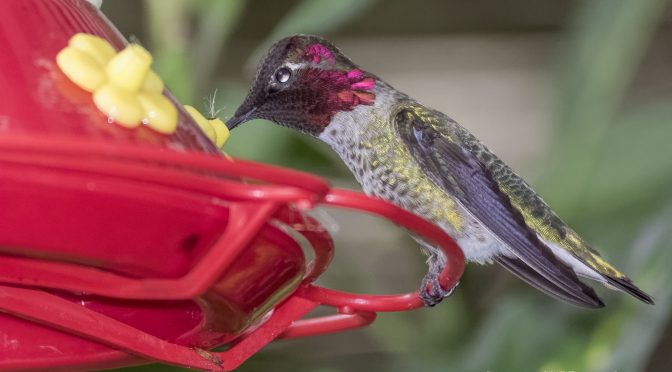While visiting the Saanich Peninsula in British Columbia I recently had the opportunity to experiment using the Nikon 1 V3 flash to photograph hummingbirds. The lighting at the location was quite poor, with the hummingbirds frequenting two feeders both of which were positioned under a permanent canopy. I was unable to get a decent exposure even when using ISO-6400. Rather than simply give up on the opportunity I decided to try using the built-in flash on the Nikon 1 V3 to photograph hummingbirds.
NOTE: Click on images to enlarge.

My first concern was how well the V3’s built-in flash would work with the 1 Nikon CX 70-300mm f/4.5-5.6 zoom mounted on the V3. I was pleasantly surprised to find out that there was no issue with the v3’s flash casting any shadows from the lens.

Using the V3’s built-in flash meant photographing hummingbirds at a shutter speed of 1/250. This was significantly slower than I would typically use, but I decided trying to get some images was better than not trying at all. I began by focusing on capturing images of perched hummingbirds.

The hummingbirds were quite active and only perched for a couple of seconds before hovering again, or simply darting away. This afforded very little time to acquire focus on a subject bird and capture an image. At times they perched then flew off so quickly that the VR on my CX 70-300mm didn’t have time to settle. This made it difficult to get properly framed images. As a result I took a bit of a risk and captured some of the flash images with VR turned off.

I noticed some hesitation from the time that I pressed the shutter on my V3 until the flash would fire. Initially I missed almost every image opportunity. I needed to anticipate where the hummingbird would be positioned when the flash actually fired. To have any hope of success I needed to pre-focus my lens on that approximate spot, then reacquire focus on a hummingbird when it ventured close.

It was certainly a treat to be able to see and try to photograph hummingbirds of various species. The eastern part of Canada where I reside only has one species, the Ruby Throated Hummingbird.
The various specimen at Butchart Gardens definitely had their own personalities, with some being extremely skittish making them especially challenging to photograph.

The built-in flash on the Nikon 1 V3 isn’t very powerful. In order to get decent exposures I needed to position myself no more than about 8-10 feet away from the feeders. Anything further than that resulted in underexposed images. After a bit of experimentation I decided to use spot metering.

By observing the feeding behaviours of the birds I was able to determine the best shooting angles to use at each of the feeders. I tried shooting with single point auto-focus as well as continuous auto focus with subject tracking, having more success with the second approach.

I wasn’t expecting to get many ‘keepers’ shooting these fast moving birds at 1/250th with the V3’s small built-in flash. With some practice and patience I did get some usable images.

After an hour or so attempting to photograph perched hummingbirds I tried my hand at capturing images of them hovering. This was far more challenging as I had to capture them hovering in one spot in mid-air. Suffice to say I had many more failed attempts than when photographing perched birds. My next article will feature some images of hummingbirds in flight.
NOTE:
All images captured hand-held using a Nikon 1 V3 with 1 Nikon CX 70-300mm f/4.5-5.6. Built in V3 flash was used. All images in this article were produced from RAW files using my standard process of DxO OpticsPro 11, CS6, and the Nik Suite
My intent is to keep this photography blog advertising free. If you enjoyed this article and/or my website and would like to make a modest $10 donation through PayPal to support my work it would be most appreciated. You can use the Donate button below. Larger donations can be made to tom@tomstirr.com through PayPal.
Article and all images Copyright 2017 Thomas Stirr. All rights reserved. No use, duplication or adaptation of any kind is allowed without written consent. If you see this article reproduced anywhere else it is an unauthorized and illegal use. Posting comments on offending web sites and calling out individuals who steal intellectual property is always appreciated!


Awesome your delighted in the pictures i love photography. thanks for great photography sharing
Glad you enjoyed the images!
Tom
happy you delighted in the pictures! My most loved is number seven also.
Thanks Monalisa!
Tom
Great pictures. Where did you take them? I am trying to get some hummingbird pics for quite a while and I cannot find a place in Southern Ontario…
Hi Dan,
The images were captured on the Saanich Peninsula in British Columbia. Where are you located in Southern Ontario?
Tom
I have never used the built-in flash on my V3 due to reading some negative comments in the past. Your article gives me a good reason to use it.
Tom, you always takes good photos.
Hi Ming,
I had never used mine either as I originally thought it was too small to be effective. I was pleasantly surprised with the images the built-in flash helped me capture. Thanks for the positive comment about the images.
Tom
Great shots, as always. WEJ
Thanks WEJ – glad you liked them!
Tom
My goodness what a challenge! And you and the camera did a wonderful job at it. These are such lovely birds. My favorite photo is number seven – I like his or her dropped wings – guess giving them a tiny brake while drinking.
Hi Joni,
I’m glad you enjoyed the images! My favourite is number seven as well.
Tom